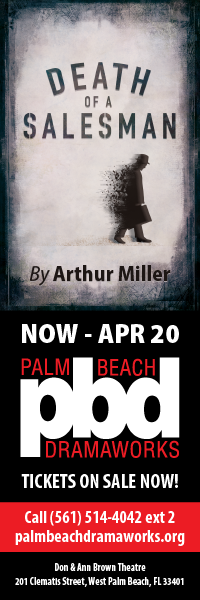
Magan Dee Yantko as Little Red Riding Hood, Bruno Vida as Jack, Arielle Jacobs as the Baker’s Wife and J.J. Caruncho as the Baker go into a decidedly Miami forest in a publicity photo for Into The Woods / Photo by Justin Namon
By Bill Hirschman
DreamCatcher Theatre is well named.
When J.J. Caruncho was young, his family would drive by an imposing three-story theater in the neighborhood and he would dream. “I’m going to buy that someday,” he recalls now. “I’m going to save the Coconut Grove Playhouse.”
A few years later as teenagers dreaming of theater, he and his sister Natalie watched construction begin in downtown Miami on the Carnival Center for the Performing Arts, sparking their imagination. She says, “I remember loving that it looked like two ships passing.”
The siblings eventually built their careers as actors/dancers/musicians in New York City, but now in their mid-20s, the Carunchos have returned to that gleaming arts facility in their hometown this season to produce the first project of their new company, DreamCatcher Theatre.
What promises to be a lavish large-scale production of Stephen Sondheim and James Lapine’s musical Into The Woods opens Thursday in DreamCatcher’s co-production with the Arsht Center’s initiative to produce its own works, Theater Up Close.
“Our journey has led us back where we started,” Natalie wrote in an email. “We are producing our first show with a brilliant cast, beautiful set, gorgeous lighting and we are home. The Arsht Center has allowed us to do what we love at home.”
The ensemble production will be headlined by Arielle Jacobs, who was the last Nina in In The Heights on Broadway, as the Baker’s Wife; and in a move that has garnered national attention, Broadway stalwart Tituss Burgess of The Little Mermaid will play the Witch, an African-American male in a role often played by a white woman.
Even after a year and a half of intense planning and preparation, J.J. was too excited to be exhausted earlier this month even though he is co-artistic director, a producer, playing the part of the Baker and serving as production manager until his sister could come down from New York. His effusive speech was punctuated every few minutes with the words “massive,” as in the scope of the production, and “brilliant,” used to describe his colleagues.
“It’s going to be a special, special production. I think it will be on a level that people aren’t used to seeing,” the wiry bearded young man gushed. “If it was in New York, I think it would still be a level that people aren’t used to seeing.”
“If you get your wish….”
The Carunchos chose the Native American totem of a dreamcatcher — a dangling circle created of leather and feathers – because dreaming resonated with their commitment to storytelling as the foundation of theater.
On their website, the siblings wrote more about their inspiration: “…the great theatre companies of the past that were created by actors who spoke the same language and just wanted to be in a room with other actors. We hope to continue to find rooms to fill with visceral, engaging and magical storytelling experiences for audiences and for ourselves.”
Although Natalie is only 28 and J.J. is 25, both have a busy career in New York. But as they performed over the years, an idea coalesced, J.J. said.
“Natalie and I have been talking about the idea of DreamCatcher since 2008. When we first started talking about it… there weren’t a lot of companies that were artist driven, not that those companies aren’t artists, but not where the actors are saying ‘So what play do we think is worth telling?’ ”
 One impetus was that many regularly working theater people in New York have Florida roots. “Our friends, the people we hang out with are like the Justice League… If we wanted to get our friends together to do a play, we could get people together who (audiences) would pay five times as much to see on Broadway,” J.J. said.
One impetus was that many regularly working theater people in New York have Florida roots. “Our friends, the people we hang out with are like the Justice League… If we wanted to get our friends together to do a play, we could get people together who (audiences) would pay five times as much to see on Broadway,” J.J. said.
But the more successful an actor becomes, the more they become tied to the enviable but diminishingly fulfilling grind of doing eight shows a week, 52 weeks a year in a long run. The need to pay the rent often works against an actor taking creative risks at low or no pay, Natalie said.
She wrote,” No one tells you when you are starting a career as an artist, an actor/ dancer/ singer/ musician that when you get to New York City your life can become a series of auditions and these gaps in between getting to do the work you set out to do. And, sometimes, having to do work that doesn’t necessarily feel like what J.J. and I call ‘the goods.’ As artists, J.J. and I both found that we have this yearning to surround ourselves with other like-minded artists and create opportunities to do the kind of work that we really believe in and got into ‘the business’ to do.”
What if they could gather their friends in New York on an ad hoc basis, hook up with their Miami contacts and have them all dedicate themselves to a comparatively brief period in which they could produce a limited run show that reawakened their creative spirit, and then go back to their other jobs.
A major benefit was they could bring their vision to their hometown. That would create a mutually beneficial cross-pollination of primarily regional theater artists and New York-centric artists.
So the siblings targeted one of their favorite shows, Into The Woods, with its focus on “the idea that the things you say and how you say them matter,” J.J. said, quoting a Sondheim lyric: “Careful the things you say, people will listen.”
Taking on a Masterpiece
Into The Woods has been one of Sondheim’s most frequently produced works, embraced by professionals around the world, community theaters and even middle schools in an abbreviated form. It weaves into the same world various fairy tales in which everyone sets off on diverse quests to achieve their wishes by entering the dark woods. The stories end happily halfway through the show, but then the consequences of their actions boomerang on them and they must learn to cope with death, injury and betrayal. Written more than a quarter-century ago, its themes resonate deafeningly with a prescience of a post-9/11 world awash in fear, uncertainty, dashed dreams, partisan finger-pointing and a rasher of other current ills.
But its themes about choices and consequences have additional resonance for the Carunchos and their colleagues. J.J. said, “The way you choose to handle your path and how you decide your own fate matters. So, for a company that is largely about taking control of your own fate, it was just a very obvious choice.”
The musical tried out in San Diego in 1986 and premiered on Broadway in 1987. That led to scores and scores of productions including a Roundabout Theatre production that will open in Manhattan the same day as DreamCatcher’s — except with only 10 actors and one piano.
The elephant in the balcony is the film version, which opened Christmas Day with Meryl Streep as the Witch. DreamCatcher and Arsht leaders hope that the film has intrigued patrons, not dissuaded them. Indeed, the film and the theater piece have completely different methods of storytelling.
The Carunchos have loved the show since they were children. It was a life-changing piece for J.J. who was more interested in playing the saxophone as a pre-teen. Then, he said, “Natalie played the Baker’s Wife when she was 14 in high school. She was brilliant, actually, which doesn’t surprise me. But that’s when I thought, ‘Wait a minute. Theater can do this?’ ”
While stripped-down versions have been attempted, the show usually requires considerable resources. This production has all of that, J.J. said: an atmospheric set including menacing trees and a 15-foot tower, lush costuming, a cast of 20 including 12 Equity actor contracts following auditions in New York and Miami drawing 1,000 applicants, plus 11 musicians and a creative team drawn from Florida and the rest of the East Coast.
For instance, the Carunchos tapped Justin Fortunato of Pittsburgh because he “is the best director I ever worked with,” J.J. said.
But much of the supporting cast is from Florida including Carbonell nominees and winners. The roster lists Bruno Vida as Jack, Laura Turnbull as Jack’s Mother, Laura Hodos as Cinderella’s Stepmother, Cristina Flores as Florinda, Elaine Flores as Lucinda, Elizabeth Dimon as Granny and the Giant, Jeni Hacker as Cinderella’s Mother, Annette Navarro as Snow White, Oscar Cheda as Cinderella’s Father, and Wayne LeGette as the Narrator and Mysterious Man.
Similarly, musical director Robert Neumeyer is from Pittsburgh, a colleague of Fortunato who worked with the director on a 2011 production of the show. But the orchestra conductor Ron Castonguay works at Gulliver Academy, Natalie’s alma mater. The set designer is K. April Soroko, a University Miami educator who won praise last month for her work on My Old Lady at Palm Beach Dramaworks.
J.J said he and Fortunato had “a deep agreement about getting actors first and foremost, not singers first and foremost. But it just so happens that they are all brilliant singers, but we (hired) all of them because they are brilliant storytellers first and foremost.”
All this costs money. Neither J.J. nor the Arsht would reveal how much. The Arsht has invested money and resources, but the Carunchos reportedly have raised the rest from various unnamed investors.
But the result is, J.J. says, “massive. I’ve seen a lot of productions. The level of storytellers (in this show) is that if somebody paid four times as much (for a ticket) and this was a show that you saw in New York, you would (still) be talking about it in several years.”
The aesthetic vision of the work “is delving very deeply. It’s Brothers Grimm not Mother Goose,” J.J. said. “We’re not making it any darker necessarily than it is, but it is going to be as close to the Chekhov drawing room version of Into The Woods as you have ever seen. Stylistically, it will be as realistic and as honest as we can. It just happens to take place in this incredible and magical world.”
“It Takes Two”
The project would have been difficult if not impossible except for the support of the Arsht Center. Theater Up Close has nurtured locally-produced events in tandem with fledgling or small theater companies including Zoetic Stage, Alliance Theatre Company, Mad Cat Theater Company and the University of Miami theater department. With Into The Woods as with the other productions, the Arsht chips in cash, marketing resources, its well-equipped black box theater space and rehearsal hall, plus the experience and advice of its staff.
Those previous productions prompted the Carunchos to pitch their idea to the Arsht Executive Vice President Scott Shiller. Several statements struck a chord with Shiller. “I heard Natalie talk about growing up in Miami and how they wished there had been the robust opportunities” available now, Shiller said.
Another was how they “talked about a cultural exchange and the opportunity for Miami actors to inspire the New York actors,” he added.
The third was their vision of embracing the diversity that is Miami, Shiller recalled, “the diversity in the types of the shows they would do and the diversity of the actors…. When they were talking about color-blind casting and diversity, (they spoke as if) it was already assumed ‘why wouldn’t we cast diverse people in these roles?’ It resonated to hear them talk about diversity in a way that was totally organic and true to their core.”
Indeed, its diversity has made headlines around the country for its casting of Burgess, a black man, as The Witch. Burgess had often spoke to the Carunchos of his desire to do the role. While the part initially was played by Bernadette Peters in 1987, a white woman, it was played later by a range of diverse women include Vanessa Williams, an African American.
“It’s just actually that he happens to be one of the best musical theater actors of our time. Because of his range as an actor and a vocalist, he was the best actor who came in for it,” J.J. said.
But Sondheim is notoriously careful about protecting the integrity of his shows. He shut down a Coconut Grove Playhouse production of the revue Side by Side By Sondheim when the material was “augmented” without permission in 2001. His representatives insisted that Palm Beach Dramaworks add more actors last summer in mid-run when its concert production of Company was mounted with fewer actors and characters than the script called for.
The company asked the licensing company Music Theatre International to ask for Sondheim and Lapine’s blessing. No one has spelled out what the creators said, but apparently MTI approved the casting.
The Caruchos stressed that not a key or note or word has been changed. The Witch is always referred to as “she,” “her” and “mother.” J.J. said “He’s not playing a warlock; he’s playing the Witch exactly as written. So anybody coming in and expecting some really heavy concept would be disappointed. They will forget in a couple of seconds because he’s just a brilliant actor doing brilliant work.”
Beginnings
Natalie is an actress/singer/dancer who performed as the understudy and in the ensemble of the first national tours of In The Heights and Flashdance, including the former’s appearances in Fort Lauderdale and at the Arsht. In the latter, she also served as a dance captain and later became its associate choreographer. She is a 2004 graduate of the Gulliver Prep and received a BFA in Acting from Florida State University. She also has a blog, www.musingsofanartist.com/readthis. When she first got the tour job in 2009, she told the Miami Herald that she hoped someday to return home and create a community theater.
J.J., a 2007 graduate of Palmetto High known as Joe when he was growing up, describes himself as a “singer/fighter/dreamer” and “storyteller.” He has trained in various kinds of music including opera, and specialties such as close quarter combat.
They were born and raised in Miami in a Cuban American household “surrounded by dancing and music and love,” Natalie wrote. Their mother, Gerri Barreras, is the dance director at Gulliver Prep. Their father, Joseph Caruncho Sr., is a trumpet player turned lawyer turned entrepreneur whose last project was Preferred Care Partners until they sold in 2012.
The DreamCatcher crew has been too busy to be dreaming much past this production. They certainly hope to continue, but they won’t be held to traditional expectations.”
There is “no next one yet,” J.J. said. “Eventually, our goal is be a company that can bridge New York and Miami, but I don’t know if it’s one (show here) and one (show there). We don’t have a schedule like ‘do one a season’ because if we can’t find a story worth telling, we’re not going to do it because audiences deserve better and there’s no purpose. ”
Before running off to rehearsal, he added, “If it’s not a story that we need to tell, we wouldn’t do it. “
Into The Woods runs Jan. 22 to Feb. 15 at the Ziff Ballet Opera House at the Adrienne Arsht Center for the Performing Arts, 1300 Biscayne Blvd., Miami, a co-production of the Arsht Theater Close Up series and DreamCatcher Theatre. Performances are 7:30 p.m. Wednesday-Saturday; 2 p.m. Saturday-Sunday. Tickets are $50. For more information, call (305) 949-6722or visit arshtcenter.org.
To read more about DreamCatchers, visit its website by clicking here.







 A PaperStreet Web Design
A PaperStreet Web Design
